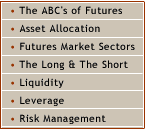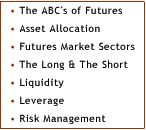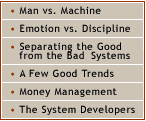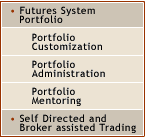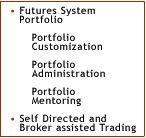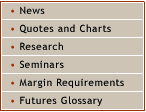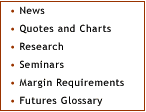A
self-regulatory organization for the commodity futures industry
comprised of firms and individuals that conduct business with the
public. Overseen by the CFTC
Nearby
|
|
The
nearest active trading month of a futures or options on futures
contract. Also referred to as the lead month. |
Non-serial
options
|
|
Options
for months for which there are existing futures contracts of the
same months. |
Not-held (NH)
|
|
A
discretionary note on an order telling the floor broker that he or
she won't be held accountable if the trade is executed outside the
requirements of the order. Gives the broker discretion on getting
the order filled. |
Offer
|
|
Indicates
a willingness to sell a futures contract at a given price. |
Offset
|
|
Selling
if one has bought, or buying if one has sold, a futures or options
on futures contract. |
Offsetting a
hedge
|
|
For
a short hedger, to buy back futures and sell a commodity. For a long
hedger, to sell back futures and buy a commodity. |
Offsetting a
long option
|
|
Offset
a put by selling a put with the same strike price. Offset a call by
selling a call with the same strike price. |
Opening
|
|
The
beginning of the trading session. |
Opening range
|
|
The
range of prices at which the first bids and offers were made or
first transactions were completed. Must be initiated by at least one
trade. |
Open interest
|
|
Total
number of futures or options on futures contracts that have not yet
been offset or fulfilled for delivery. |
Open order
|
|
See
Good-til-canceled. |
Open outcry
|
|
The
method of trading publicly so that each trader has a fair chance to
buy or sell. |
Option
|
|
The
right, but not the obligation, to sell or buy the underlying (in
this case, a futures contract) at a specified price within a
specified time. |
Option
assignment
|
|
The
random selection of an option writer to take a futures position when
an option is exercised. |
Option buyer
|
|
One
who purchases an option and pays a premium. |
Option seller
|
|
One
who sells an option and receives a premium. |
Order-cancels-other
(OCO)
|
|
An
order that includes two orders, one of which cancels the other when
filled. Also referred to as one-cancels-other. |
Out-of-the-money
|
|
An
option with no intrinsic value. A call option with a strike price
greater than the underlying futures price. A put option with a
strike price less than the underlying futures price. |
Out-trades
|
|
A
situation that results when there is some confusion or error on a
trade - for example, when both traders think they were buying. |
Overbought/oversold
|
|
A
technical opinion of a market which has risen/fallen too much in
relation to underlying fundamental factors. |
Performance bond
|
|
Funds
that must be deposited by a customer with his or her broker, by a
broker with a clearing member or by a clearing member with the
Clearing House. The performance bond helps to ensure the financial
integrity of brokers, clearing members and the Exchange as a whole.
Previously referred to as margin. |
Performance bond
call
|
|
A
demand for additional funds to bring the customer's account back up
to the initial performance bond level whenever adverse price
movement has caused the account to go below the maintenance.
Previously referred to as a margin call. See Maintenance performance
bond. |
Point and figure
chart
|
|
A
graph of prices charted with x's for price increases and o's for
price decreases, used by the chartist for buy and sell signals. |
Position
|
|
An
interest in the market, either long or short, in the form of open
contracts. See Open interest. |
Position trader
|
|
A
trader who takes a position in the market and might hold that
position over a long period of time. |
Premium
|
|
The
amount agreed upon between the buyer and seller for the purchase or
sale of a futures option - the buyer pays the premium and the
seller receives the premium. The excess of one futures contract
price over that of another or over the cash market price. |
Price order
|
|
An
order to sell or buy at a certain price or better. |
Pure hedger
|
|
A
person who places a hedge to lock in a price for a commodity. He or
she offsets the hedge and transacts in the cash market
simultaneously. |
Put breakeven
|
|
See
Breakeven. |
Put option
|
|
An
option granting the right, but not the obligation, to sell a futures
contract at the stated price prior to the expiration of the option. |
Put profit/loss
|
|
For
a long put, equal to the put value minus the premium. For a short
put, equal to the premium minus the put value. |
Put value
|
|
At expiration, equal to the strike price minus the futures price. |
Rally
|
|
An
upward movement of prices following a decline. The opposite of a
reaction. |
Range
|
|
The
high and low prices or high and low bids and offers recorded during
a specified time. |
Retracement
|
|
A
price move in the opposite direction of a recent trend. |
Registered
representative
|
|
A
person employed by, and soliciting business for, a commission house
or futures commission merchant. |
Resistance line
|
|
A
price level above which prices tend not to rise due to selling
pressure. |
Round-turn
|
|
See
Commission. |
Runaway gap
|
|
A
gap in prices after a trend has begun that signals the halfway point
of a market move. |
Scalp
|
|
To
trade for small gains. Scalping normally involves
establishing and liquidating a position quickly, usually within the
same day, hour or even just a few minutes. |
Selective hedger
|
|
A
person who hedges only when he or she believes that prices are
likely to move against him or her. |
Selling climax
|
|
An
extraordinarily high volume occurring suddenly in a downtrend
signaling the end of the trend. |
Serial options
|
|
Options
for months for which there are no futures contracts. The underlying
futures contract for a serial option month would be the next nearby
futures contract. |
Settlement price
|
|
A
figure determined by the closing range that is used to calculate
gains and losses in futures market accounts, performance bond calls
and invoice prices for deliveries. See Closing range. |
Short
|
|
One
who has sold a futures contract to establish a market position and
who has not yet closed out this position through an offsetting
procedure. The opposite of long. |
Short cash
|
|
Describes
a trader who needs and plans to buy a commodity. |
Short hedge
|
|
The
sale of a futures contract in anticipation of a later cash market
sale. Used to eliminate or lessen the possible decline in value of
ownership of an approximately equal amount of the cash financial
instrument or physical commodity. See Hedge. |
Sideways trend
|
|
Seen
in a bar chart when prices tend not to go above or below a certain
range of levels. |
Speculator
|
|
One
who attempts to anticipate price changes and, through buying and
selling futures contracts, aims to make profits. Does not use the
futures market in connection with the production, processing,
marketing or handling of a product. The speculator has no interest
in taking delivery. |
Spot Price
|
|
See
Cash price. |
Spread
|
|
The
price difference between two contracts. Holding a long and a short
position in two related futures or options on futures contracts,
with the objective of profiting from a changing price relationship. |
Spread order
|
|
An
order that indicates the purchase and sale of futures contracts
simultaneously. |
Spread trade
|
|
The
simultaneous purchase and sale of futures contracts for the same
commodity or instrument for delivery in different months or in
different but related markets. A spreader is not concerned
with the direction in which the market moves, but only with the
difference between the prices of each contract. |
Stop close only
order
|
|
A
stop order that is executed only during the closing range of the
trading session. |
Stop limit order
|
|
An
order that becomes a limit order only when the market trades at a
specified price. |
Stop order
|
|
An
order that becomes a market order only when the market trades at a
specified price. |
Stop with a
price limit
|
|
A
stop order with a specified worst price at which the order can be
filled. |
Storage gain
|
|
The
selling price received after storage minus the previous harvest
market price. |
Straddle
|
|
The
purchase of a put and a call, in which the options have the same
expiration and same strike price, called a long straddle.
Also, the sale of both a put and a call in which the options have
the same expiration and same strike price, called a short
straddle. |
Strangle
|
|
The
purchase of a put and a call, in which the options have the same
expiration and the put strike is lower than the call strike, called
a long strangle. Also the sale of a put and a call, in which
the options have the same expiration and the put strike is lower
than the call strike, call a short strangle. |
Strike price
|
|
The
price at which the option buyer may purchase or sell the underlying
futures contract upon exercise. See Exercise price. |
Supply
|
|
The
quantity of a commodity that producers are willing to provide to the
market at a given price. |
Symmetrical
triangles
|
|
A
price formation that can either signal a reversal or a continuation
of price movement. |
Synthetic
futures
|
|
A
combination of a put and a call with the same strike price, in which
both are bullish, called synthetic long futures. Also, a
combination of a put and a call with the same strike price, in which
both are bearish, called synthetic short futures. |
Synthetic call
option
|
|
A
combination of a long futures contract and a long put, called a synthetic
long call. Also, a combination of a short futures contract and a
short put, called a synthetic short call. |
Synthetic option
|
|
A
combination of a futures contract and an option, in which one is
bullish and one is bearish. |
Synthetic put
option
|
|
A
combination of a short futures contract and a long call, called a synthetic
long put. Also, a combination of a long futures contract and a
short call, called a synthetic short put. |
Target price
|
|
An
expected selling or buying price. For long and short hedges with
futures: Futures Price + Expected Basis. For puts: Futures
Price - Premium + Expected Basis. For calls: Futures Price +
Premium + Expected Basis. |
Technical
analysis
|
|
The
study of historical price patterns to help forecast futures prices. |
Theta
|
|
The
measure of the change in an option's premium given a change in the
option's time until expiration. Equal to the change in the option's
premium divided by the change in time to expiration. |
Tick
|
|
Refers
to a change in price, either up or down. See Minimum price
fluctuation. |
Time value
|
|
The
amount by which an option's premium exceeds the intrinsic value of
the option. Usually relative to the time left to expiration. |
Trader
|
|
A
member of the exchange who buys and sells futures and options on the
floor of the exchange. See Day trader, Floor broker, Position trader
and Scalper. |
Trend
|
|
The
general direction of the market. |
Uptrend
|
|
A
price trend characterized by a series of higher highs and higher
lows. |
Vega
|
|
The
measure of the change in an option's premium for a 1% change in the
volatility of the underlying futures contract. Equal to the change
in premium divided by 1% change in volatility. |
Vertical spread
|
|
The
purchase of a call (put) and the sale of a call (put), where the
options have the same expiration and different strike prices. |
Volatility
|
|
A
annualized measure of the fluctuation in the price of a futures
contract. Historical volatility is the actual measure of
futures price movement from the past. Implied volatility is a
measure of what the market implies it is, as reflected in the
option's price. |
Volume
|
|
The
number of transactions in futures or options on futures made during
a specified period of time. |
With discretion (DISC) |
|
A
discretionary note on an order telling the floor broker to use his
or her own discretion in filling the order. |
Writer
|
|
An
individual who sells an option. |

